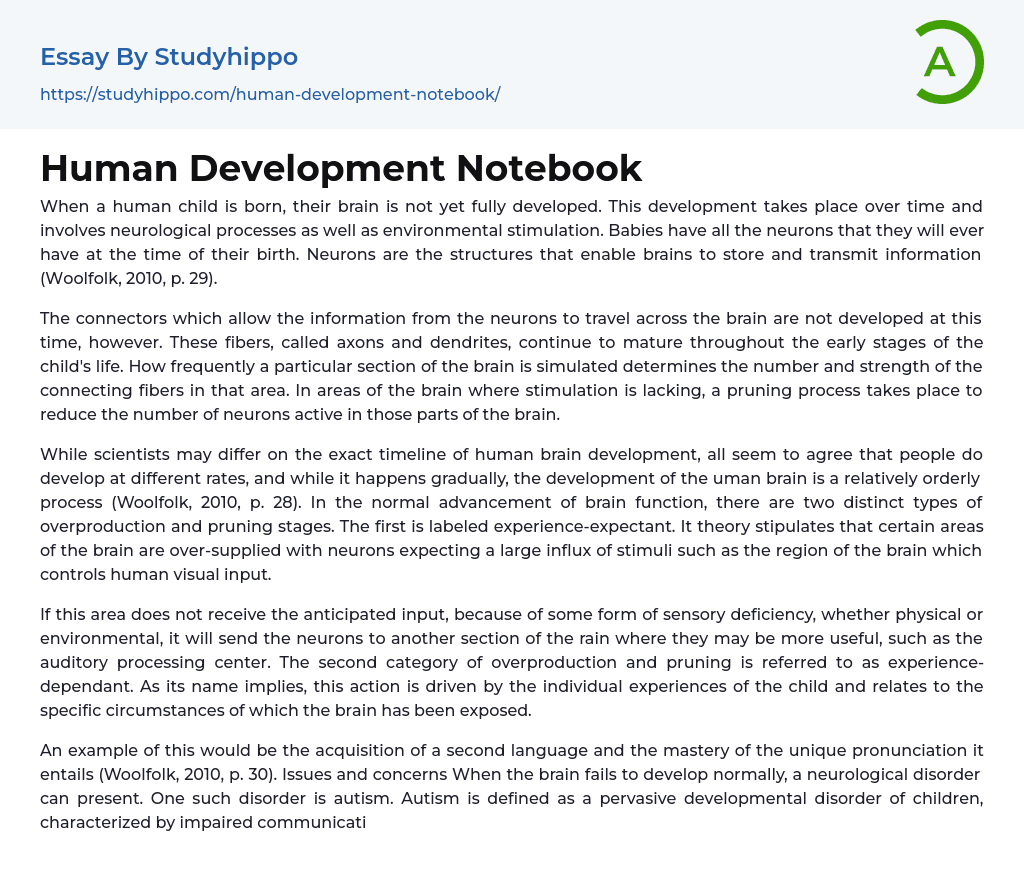At birth, a human child's brain is not fully developed and requires neurological processes and environmental stimulation for development. Nevertheless, babies are born with all the neurons needed for information storage and transmission (Woolfolk, 2010, p. 29).
The development of connectors, known as axons and dendrites, that allow information to travel across the brain is incomplete. These fibers continue to mature during the early stages of a child's life. The frequency of stimulation in specific brain regions determines the quantity and strength of the connecting fibers. In regions with inadequate stimulation, a pruning process occurs to reduce the number of active neurons in those areas.
Scientists generally agree that while the timeline of human brain development may vary, individuals do develop at different rates. The development of the human brain is considered a relat
...ively organized process, albeit gradual (Woolfolk, 2010, p. 28). During the normal progression of brain function, there are two distinct stages: overproduction and pruning. The first stage, known as experience-expectant, involves certain areas of the brain being provided with an excess of neurons in anticipation of receiving a substantial amount of stimuli. This is particularly evident in the brain region responsible for processing visual input in humans.
If the expected input to this area is not received due to a sensory deficiency, whether physical or environmental, the neurons will be redirected to a different section of the brain that may be more beneficial, such as the auditory processing center. This second category of overproduction and pruning is known as experience-dependent, meaning it is influenced by the specific experiences of the child and the circumstances in which the brain has been exposed.
<
align="justify">According to Woolfolk (2010, p. 30), acquiring a second language and mastering its distinctive pronunciation requires concentrated attention. Autism, as defined by http://dictionary.reference.com/browse/autism, is a neurological disorder resulting from inadequate brain development. It is characterized by communication difficulties, inflexible behavioral patterns, and emotional detachment. Typically, symptoms of autism emerge before the age of three and may involve delayed language acquisition. Moreover, autism impacts not only the individual but also their entire family.
The National Institute of Health (http://www.inds.nih.gov/disorders/autism/detail_autism.htm#155663082) states that parents and siblings of children with autism often experience increased levels of stress-related problems. Counseling can be beneficial in helping them deal with the difficulties of living with autism. Additionally, it is strongly advised for children diagnosed with autism to receive training in life skills, job skills, and social skills.
Research from http://en.wikipedia.org/wiki/Autism shows that early intervention is crucial for improving life skills and coping abilities in children with autism. Unfortunately, it is uncommon for adults with autism to experience symptom reduction and achieve independence. Teachers encounter multiple challenges when they have students with autism in their classrooms.
To improve the learning environment for all students, different strategies can be used in the classroom depending on the severity of the disorder. For example, if a student with autism is present, one approach is to assign them a "buddy" and create a designated "safe base" where they can go if they feel overwhelmed by the classroom atmosphere (Woolfolk, 2010, p. 144). Additionally, structured teaching, speech and language therapy, social skills therapy, and occupational therapy are other methods that can enhance the educational experience for students with autism.
It is crucial to have a consistent and
predictable routine when teaching a child with autism. They may need specialized speech classes and guidance on how to interact socially, as they often find it difficult to understand social expectations. Teachers must work closely with the team in charge of the student's educational plan and diagnostic report to make sure that there are no major differences between recommended programs and their actual implementation.
Physical development refers to the changes in body structure and function that occur over time (Woolfolk, 2010, p. 559). There are two main principles that govern this development. Firstly, normal human development follows a top-to-bottom pattern. At birth, babies have relatively larger heads compared to their bodies, making up about one-fourth of their total body size. As individuals grow, their bodies increase in size at a faster rate than their heads, resulting in the head representing approximately one-eighth of the overall body mass in typically developing humans.
Babies require neck support at birth as their musculature structure is not fully developed. They lack the ability to sit up, grasp objects, and have limited control over their hands and feet. Nevertheless, as they mature, babies progressively acquire control over their neck muscles, then their arms and trunk. Eventually, they develop command over their legs and can initiate crawling by rocking on their knees.
- Alzheimer's Disease essays
- autism essays
- Epilepsy essays
- Sleep essays
- Sleep Deprivation essays
- Traumatic Brain Injury essays
- Action Potential essays
- Blood essays
- Body essays
- Brain essays
- Childbirth essays
- Eye essays
- Glucose essays
- Heart essays
- Human Physiology essays
- Immune System essays
- Kidney essays
- Muscle essays
- Nervous System essays
- Neuron essays
- Poison essays
- Puberty essays
- Sense essays
- Skeleton essays
- Skin essays
- Adaptation essays
- Adventure essays
- Adversity essays
- Aging essays
- Alcohol essays
- Barbie Doll essays
- Beauty essays
- Care essays
- Carpe diem essays
- Change essays
- Chess essays
- Chicken essays
- Choices essays
- Contrast essays
- Crops essays
- Development essays
- Dream essays
- Evil essays
- Experience essays
- Family essays
- Farm essays
- Fire essays
- First Love essays
- Focus essays
- Greed essays




